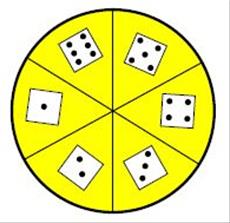0 comments
Access to Play and Learning: Selecting and Adapting Toys and Games
 2
2
‘Tis the holiday season, a time when many children…and their parents and teachers…have visions of toys dancing in their heads! Children learn through play, and toys and games can stimulate their imagination and enrich their sensory, motor, cognitive, language, emotional, and social skill development.
There are so many toys to choose from, and selecting the right toys for your children can be challenging. Ideally, you should look for toys that support universal design for learning that can be played with by children with varying skills, needs, and interests and provide equal opportunities to learn.
Many commercially available off the shelf toys and games are accessible to children who have disabilities, and others can be easily and inexpensively adapted to make them more accessible to children. An adapted toy can provide children with disabilities the same play opportunities available to other children. Adaptations can include making physical modifications to the toy, simplifying the rules of the game, and setting up the play environment and activities to provide additional ways to use the toys and provide more learning opportunities.
The National Lekotek Center offers the following Top Ten Tips for Selecting Toys for Children with Disabilities at http://www.lekotek.org/images/stories/files/pdf/packets/top_ten_tips.pdf
- Multisensory appeal: Does the toy respond with lights, sounds, or movement? Are there contrasting colors? Does it have a scent or texture?
- Method of activation: Will the toy provide a challenge without frustration? What is the force required to activate? What are the number and complexity of steps required to activate?
- Where the toy will be used: Can the toy be used in a variety of positions such as side-lying or on a wheelchair tray? Will the toy be easy to store? Is there space in the home?
- Opportunities for success: Can play be open-ended with no definite right or wrong way? Is it adaptable to the child's individual style, ability, and pace?
- Current popularity: Is it a toy most children would like? Does it tie-in with other activities like T.V., movies, books, etc.?
- Self-expression: Does the toy allow for creativity, uniqueness, and choice-making? Will it give the child experiences with a variety of media?
- Adjustability: Does it have adjustable height, sound volume, speed, level of difficulty?
- Child's individual characteristics: Does the toy provide activities that reflect both developmental and chronological ages? Does it reflect the student's interests and age?
- Safety and durability: Consider the child's size and strength in relation to the toy's durability. Are the toy and its parts sized appropriately? Does the toy have moisture resistance? Can it be washed and cleaned?
- Potential for interaction: Will the child be an active participant during use? Will the toy encourage social engagement with others?
Yes, simple adaptations can make toys more accessible. But, let’s start with using common sense for safety. If the children tend to mouth toys, be aware and cautious of providing toys with small parts, or adaptations that can come off during rough or repeated play. The Toy Industry Association provides a free guide to Fun Play Safe Play at http://www.toyinfo.org/App_Themes/tiapublic/pdfs/publications/funplay_safeplay.pdf
Ideas For Adapting Toys and Games
Stabilize toys to prevent them from sliding around or being knocked over:
- Use rubberized non-skid shelf liner as a play mat. Rolls of shelf liner that can be cut to size are usually available at dollar stores.
- Place Velcro on toys and use a looped carpet square as a play mat to place the toys on. Stores that sell carpeting are often happy to donate the squares.
- Place magnets or magnet tape on toys and use a metal cookie sheet as a play mat. Vendors often use magnetic business cards, and you can cut these up to use with your toys. Cookie sheets are often available at dollar stores. Before buying the cookie sheet, bring a magnet to make sure that magnets stick to it because the type of metal varies.
- Clamps or suction cups can be used to attach toys to table tops or wheelchair trays.
- Contain toys that move along a surface, such as battery-operated cars or animals, into a confined space so that they stay within reach of the child. Place a hula hoop on the table or floor, or place the toy inside a box lid or a tray with sides.
- Provide visual contrast by placing dark-colored toys on a light surface, and vice versa. Shine a flashlight on toys to make them visually pop.
- Provide extra sensory feedback by adding colors, sounds, and textures.
- Enlarge handles of toys with foam hair rollers, rubber balls, bicycle handle grips, sponges, sections of pool noodles, and modeling clay that hardens when dry. These same items can be used to build up crayons, markers, and paintbrushes.
- Popsicle sticks or wooden dowels can be Velcroed onto toy piano keys to provide extensions for easier access.
Puzzle adaptations:
- Attach handles to wooden puzzle pieces using drawer knobs, wooden thread spools, or dowel rods.
- Add tactile interest to puzzle pieces with sticky-back or glued-on foam pieces or other textured materials. Place yarn or Wikki Stix wax-coated yarn on pieces, or draw on them with puffy paint to outline the pictures.
- For inset puzzles, attach the hook side of Velcro to the back of each piece, and the loop Velcro in the puzzle form.
- For inset puzzles, trace the outline of the puzzle piece onto colored construction paper, cut it out, and glue it inside the form to provide visual contrast.
- For jigsaw puzzles, attach the hook side of Velcro to the back of each piece and use a looped carpet square to place the puzzle pieces onto.
- For jigsaw puzzles, make a full-size photocopy of the finished puzzle and tape it onto a cookie sheet. Attach magnetic tape to the back of each puzzle piece. Children can then place the puzzle pieces directly on the picture.
- Cover an extra-wide 3-ring binder with tempo loop fabric, rubberized shelf liner, or loop carpet square to provide a more upright play surface for better visual and physical access.
Board game adaptations:
- Make a color photocopy of the game board, laminate it, and attach it to a cookie sheet or large baking sheet. If the game board is large, you may have to copy it in sections and piece it together before laminating. Attach magnets onto the bottom of the game pieces. Also, look for games with magnetic pieces, often available in travel games.
- If the game includes cards that are too small or thin to easily grasp and manipulate, photocopy or scan the cards, enlarge, and laminate them. If you print them on card stock before laminating, they will be thicker and easier to handle. You can also place sticky-back foam or glue cardboard on the back of the cards. If the cards will be stacked on the board, place a small piece of sticky-back foam or soft Velcro on the corner of each card to help separate them.
- Add tactile interest and visual pop to game boards, game pieces, dice, and spinners using puffy paints, Wikki Stix, stick-on foam and other textures.
- Place soft Velcro dots on each space on the game board and hard Velcro dots to the bottom of game pieces to help them stay upright and provide tactile cues for counting spaces. This also works well for checkers and chess boards.
- If the game rules are difficult to understand, simplify them by changing the rules and adapting the game with fewer spaces, choices, or cards.
Dice adaptations:
- Create quiet, easy to grasp, non-slip dice from cubes made out of foam. Add dots or numbers using fabric paint or a marker.
- Create large dice using cardboard or card stock. Many printable templates are available online. The website at http://timvandevall.com/printable-paper-dice-template provides multiple templates for 6, 10, and 12-sided dice. Small bells can be placed inside to provide auditory input and additional weight.
- If dice are difficult to handle, no matter what the size, try placing standard dice inside an empty plastic water or soda bottle. Roll the bottle to roll the dice!
- Spin art machines can be found in craft or game departments. Glue a circular dice board to the spin art card, as depicted below. Place a cardboard arrow on the top edge of the spin art circle. Spin the dice by turning the spinner on and then off, and see which dice the arrow lands on. If the game requires two dice, you’ll need to spin the dice circle twice.
Do you have any favorite ideas for adapting toys, games, and play activities? If so, please post a comment and share your ideas. Thanks and Happy Holidays!
Additional resources:
- Toys “R” Us publishes a catalog of accessible toys, with descriptions of the toys’ sensory components and developmental skill supports, at http://www.toysrus.com/shop/index.jsp?categoryId=3261681
- The Alliance for Technology Access publishes Let's Play: A Guide to Toys for Children with Special Needs, with guidelines on selecting toys for children with visual, hearing, physical, and other developmental challenges. It is available at http://www.familyconnect.org/parentsite.aspx?SectionID=83
- The National Lekotek Center provides resource packets with a wealth of play ideas for all children, simple toy adaptations, and specific play tips for children with autism, attention deficit disorder, visual impairment, and more at http://www.lekotek.org/general-info/about-lekotek/resources/information-packets#Play
- Let’s Play Project - Adapting Toys: http://letsplay.buffalo.edu/toys/adapting-toys.pdf
- Wikki Stix Ideas: http://www.wikkistix.com/











